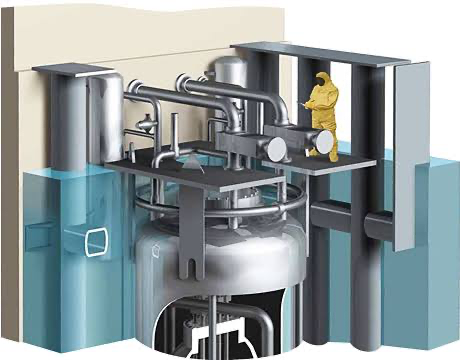At the prestigious Mining Indaba conference, Dr. Kelvin Kemm, Chairman of Stratek Global, delivered a compelling message: Small Modular Nuclear Reactors (SMRs) could hold the key to South Africa’s persistent energy challenges.
“South Africa has been ready for many years to expand its nuclear energy production as nuclear is carbon-free and provides a reliable base load,” remarked Dr. Kemm. His remarks highlighted the potential of SMRs to address the country’s energy demands sustainably.
South Africa’s venture into SMR development dates back to its pioneering Pebble Bed Modular Reactor (PBMR) project. Despite initially leading in SMR development, the government discontinued the PBMR in 2010, citing global economic downturns.
Undeterred, Dr. Kemm and fellow scientists founded Stratek Global, a private initiative. Their efforts culminated in the design of the HTMR-100, a revolutionary SMR capable of operation in remote areas without water cooling, thanks to its helium gas cooling system.
One of the key advantages of SMRs like the HTMR-100 is their affordability and diverse ownership potential. Governments, provinces, municipalities, and private entities, including mining companies, could all benefit from these compact reactors.
The HTMR-100’s operational versatility further adds to its appeal. It produces 100 MW of high-temperature gas, which can be utilised directly for industrial processes or converted into electricity through conventional steam turbines, offering flexibility to suit varied needs.
Moreover, SMRs could address South Africa’s energy cost concerns. While renewable energy sources offer competitive prices, they fall short in reliability compared to coal and nuclear. SMRs present a promising middle ground, offering lower costs than diesel-fuelled options while providing consistent power.
Identified sites for SMRs across South Africa further underscore their potential. Locations like Pelindaba and Kragbron offer ideal settings for prototype construction and component fabrication, tapping into existing industrial expertise.
The decentralised nature of SMRs presents additional benefits. Remote communities, such as mining sites, could establish dedicated microgrids powered by SMRs, bypassing the challenges of connecting to national grids.
Looking ahead, Dr. Kemm envisions a pivotal role for SMRs in meeting rising electricity demands sustainably. He emphasised the safety and reliability of fourth-generation SMR technology, underlining its capacity to provide a stable baseload amidst increasing energy needs.
“The reality is that electricity demand has doubled in the past 25 years, and it is set to double again in the next 25 years, so we need the green energy that nuclear provides as the reliable baseload,” concluded Dr. Kemm, urging stakeholders to embrace SMRs as a catalyst for a greener, more resilient energy future.
As South Africa grapples with its energy dilemma, Dr. Kelvin Kemm’s advocacy for Small Modular Nuclear Reactors offers a compelling pathway towards sustainability and resilience in power generation.
Source: ESI Africa



